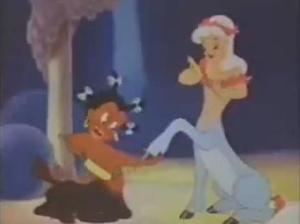I got tired of it sitting in my queue so here it goes
I got this book free on my new Kindle Fire, which was given to me as a gift. I have no money and, most importantly, I have no money to waste on badly written books, so I’m all for the freebies for right now.
Let me tell ya, there was nothing about this story that made me think “eternal seduction”—I mean, looking at the plot itself and the characters.
- The Cover—a sketch of my impression:
Pasty, thin white people with problems. A hint of goth, roses, and morbidity. Instant pop media vampire story, spun right off of Stephanie Meyer and probably that Twilight nonsense. A simple recipe. I am not impressed.
When is the romance industry going to stop with these stupid covers??? *pulling out my hair*
But there was almost a jewel under the cover. It turned out to be a few steps above that Twilight nonsense.
- The Heroine
My attitude about the book began to change with finding out that the heroine’s name is Logan, which is typically used as a masculine name. Not bad, Jennifer Turner.
I read the second part of the dedication: “And to Logan and Kerestyan, who decided to break the mold and not be the classic hero and heroine…thank you!”
So, you think so, Jennifer Turner, whoever you are.
Logan Ellis is also homeless. An interesting attempt. (It didn’t stay interesting for long.) Logan Ellis, again, another interesting thing to note about the character’s journey.
- Fatphobia/Fat Hatred
Nobody likes feeling like the main character would say or ugly, bigoted things about their body or eating habits if they were somehow to extract them from the book and meet them in real life.
“…When the fat girl stuffing her face in the corner fully recognizes food gives her the comfort she can’t find in anyone else.”
It was supposed to be some kind of profound moment so I was caught off guard considering that Logan, the main character, is a skinny bitch character, a homeless starved heroine addict who chose to live on the streets. At first, I thought she was charming but as I continue reading, she’s just becoming abrasive. That comment didn’t help my perception of her. I definitely don’t appreciate her stereotype here at all and she pairs it up with example of sexism and promiscuous men, prefacing the comment with “The moment you realize all your worst fears are true”.
But that comment and how it’s set up within the context of the story really put me off. As if of course we’re all lonely misanthropic fat girls sitting in corners huddling our foods around us and shunning people.
I visited her website and was surprised to find that Jennifer Turner appears to be a plus-size woman, like myself. That’s if the photo under the author’s section is at all recent. Politically and intellectually, I don’t understand why she would choose to write a thin character who would make a comment that, to me, sounds fatphobic, out of the blue like that when the character is trying say something important.
Whatever, after the words were said, the whole book lost its shine for me and it went downhill from there in a combustion of disappoint and barely expressed ire. The suspension of disbelief was dismissed and the good faith in the character was totaled beyond all recognition.
- The Love Interest of the Heroine
Kerestyan a pretty unusual name for me. I like it.
Kerestyan seemed pretty interesting up until the point that Logan made her fatphobic remark and I lost interest in the book. My favorite scene was the in the kitchen scene, unf.
- Preternatural “Plastic Surgery”
So after about two decades or so of wrecking her body with heroine, you’re telling this bitch gets a pass once she receives the privilege of becoming a servio? Get. Out. Of. Town.
In the same vein as the fatphobic remark made by Logan, the heroine, it seems that eternal thinness is the beauty standard for vampires. Give me a break. This metaphysical/magical “plastic surgery” adds a whole layer to my understanding of the bigotry inherent in the body image message of this book.
- Drug Trafficking in New York
So you’re telling me that after living for thousands of years, these vampires can’t figure out how to heavily mitigate drug trafficking in one primarily human city?
Sounds like the limitations of the human imaginations to me. That’s a fail, Jennifer Turner.
- Homelessness
Only presumably liberal white artists would choose to portray a story in which the white main character actively chooses to be homeless and actively chooses to be on drugs.
I feel like this was a poor decision on the author’s part and was somewhat mocking of people who are born into poverty and homelessness.
- All-Seeing Old Dude
Spare me. The all-seeing, all wise master vampires who reigns of from on high? Throne and all? The author could’ve missed me with this one. I was, overall, not impressed. The whole “very old vampire family presented as a gang/organization with selective recruiting” was another fail.




.jpg)


You must be logged in to post a comment.